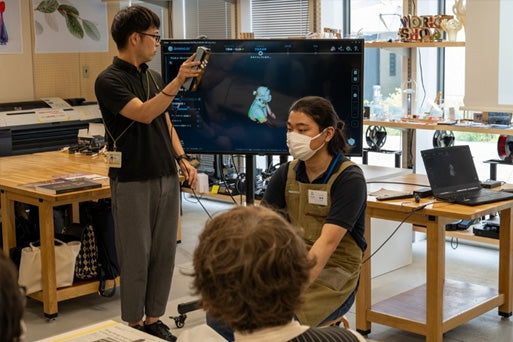On Saturday, July 8th, Kanagawa University held an event called "Reviving Kamakura's Everyday Life with FAB" at "Fab Lab FabLab MinatoMirai," located on the 1st floor of the Minato Mirai Campus. This event, conducted in cooperation with Kamakura City, aimed to allow participants to experience historical and folklore materials using the cultural properties of Kamakura City, such as the "Wooden Twelve Divine Generals Standing Statues" and "Itajime Stencils," in a workshop setting.
In the first half of the event, representatives from the Kamakura Museum of National Treasures and the Kamakura Museum of History and Culture explained the materials and their cultural backgrounds. Following this, a workshop was held where participants designed bags inspired by these cultural assets.
This report will cover the cultural assets, 3D scanning, and the event itself in two parts. This event was held based on the comprehensive partnership agreement with Kamakura City concluded in September 2021.
Kanagawa Prefecture Designated Cultural Property: Wooden Statue of the Twelve Divine Generals Inugami

The "Wooden Twelve Divine Generals Standing Inugami" statue is based on an anecdote about Inugami, one of the Twelve Divine Generals who surrounded Yakushi Nyorai in Okura Yakushido, built by Hojo Yoshitoki, the main character of last year's Taiga drama. The statue is notable for its deeply chiseled features, distinctive hairstyle, and dynamic, powerful standing pose.
According to the Kamakura period history book "Azuma Kagami," there is an anecdote about Hojo Yoshitoki and "Inugami." In 1218, Yoshitoki followed Minamoto no Sanetomo, the third shogun of the Kamakura Shogunate, to Tsurugaoka Hachimangu Shrine. The following year, when Sanetomo was appointed Minister of the Right and the ceremony was held at Tsurugaoka Hachimangu Shrine, Yoshitoki suddenly fell ill upon seeing a white dog near the tower gate. Consequently, he took over Minamoto no Nakaaki's role at the mansion and returned home. Later, on the way back from the ceremony, both Sanetomo and Nakaaki were assassinated by Kugyo, and only Yoshitoki, who was not present, survived. When Yoshitoki later visited Okura Yakushido, he heard that the dog statue had disappeared around the time of the incident. It is believed that Inugami transformed into a white dog on the day of the assassination and saved Yoshitoki's life.

About Kamakura City designated tangible cultural property "Itajime dyeing stencil"


The "Itajime dyeing stencil" is a template used for itajime dyeing and was excavated from a pit building dating back to the late Kamakura period. The pattern on the stencil depicts cherry blossoms, maples, willows, and pine trees, which were typical trees planted in areas where kemari (a traditional Japanese ball game) was played at the time. During the Kamakura period, kemari spread from aristocrats to samurai, embedding aristocratic culture among Kamakura samurai. This stencil is valuable as it highlights the cultural sophistication of the Kamakura samurai.
Many items with various patterns, including the Itajime-zome Kataita, have been excavated in Kamakura City. These artifacts are significant as they alter the traditional image of the austere and resilient samurai.
3D scanning of historical and folklore materials
Historical and folklore materials, such as those mentioned above, tend to deteriorate when unearthed. To address this, Kanagawa University utilizes 3D scanning technology. By saving the materials as 3D digital data using dedicated devices, the university can preserve their external shape and color as they were at the time of shooting. Additionally, 3D printing these data allows for the creation of replicas that can be easily handled and understood.
For this workshop, Kanagawa University conducted 3D scanning and 3D printing of the "Itajime dyeing stencil." However, the 3D printer could not reproduce the delicacy of the actual stencil. Therefore, the workshop created laser processing data based on the image data to produce stamps for the "Itajime dyeing stencil."
In the next part, Kanagawa University will report on the actual workshop.











Leave a comment
All comments are moderated before being published.
This site is protected by hCaptcha and the hCaptcha Privacy Policy and Terms of Service apply.